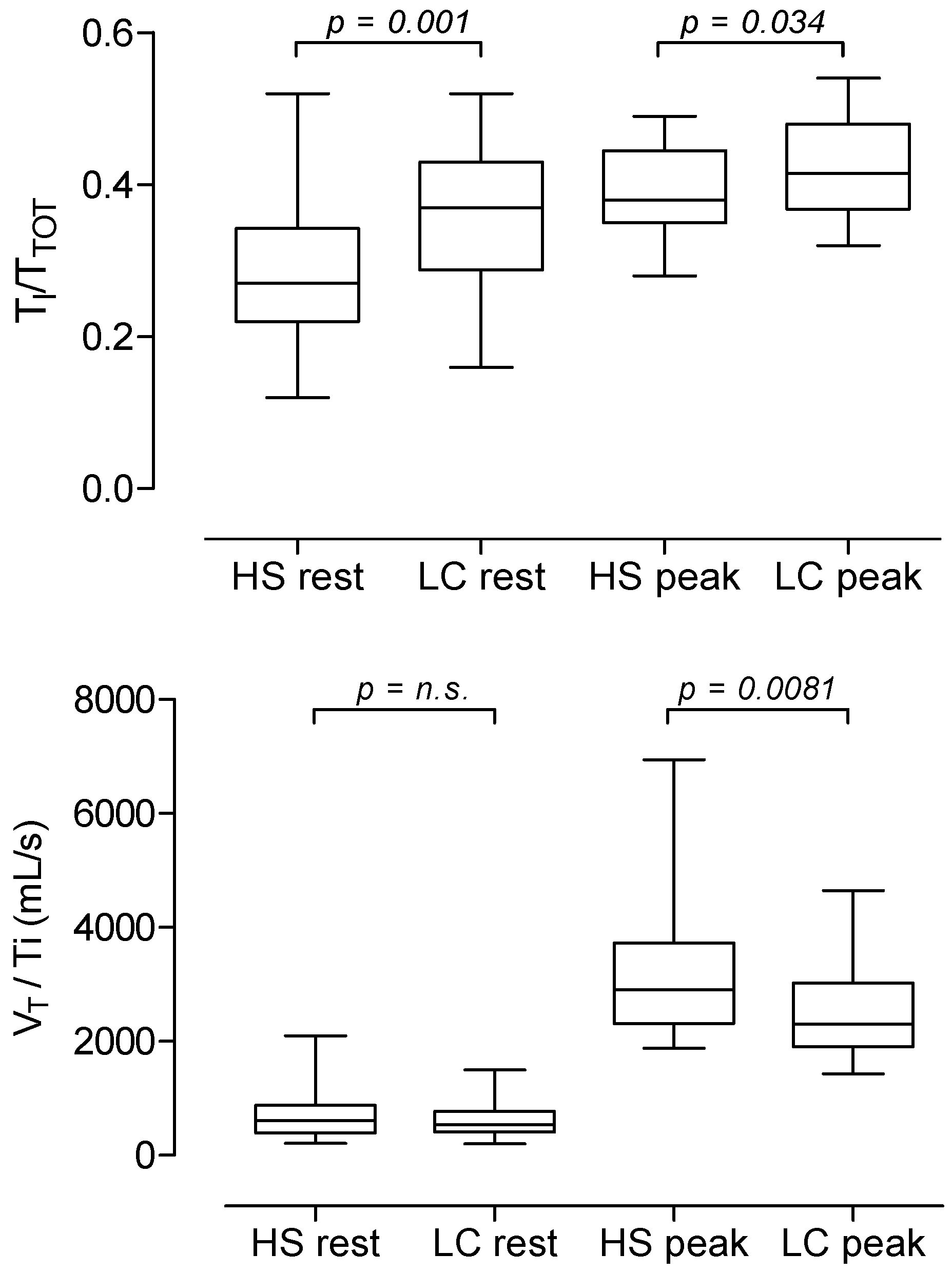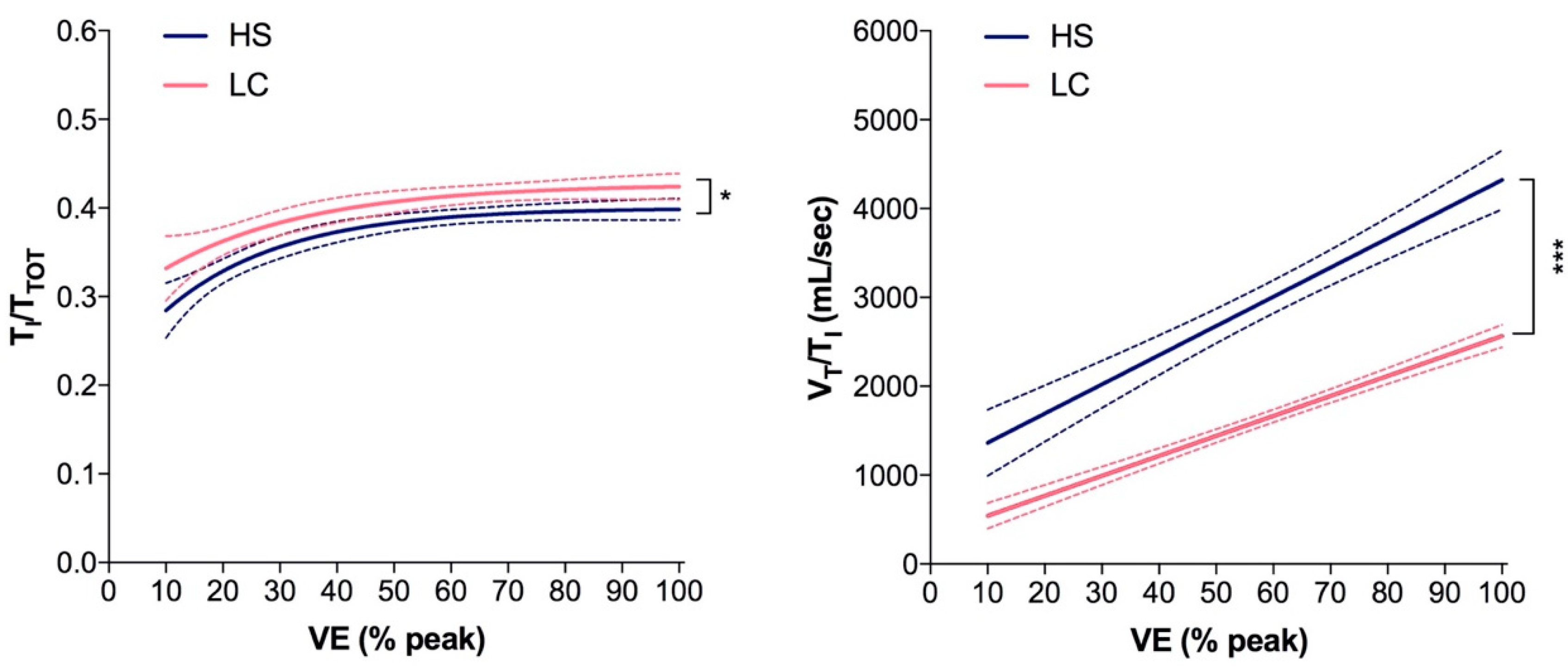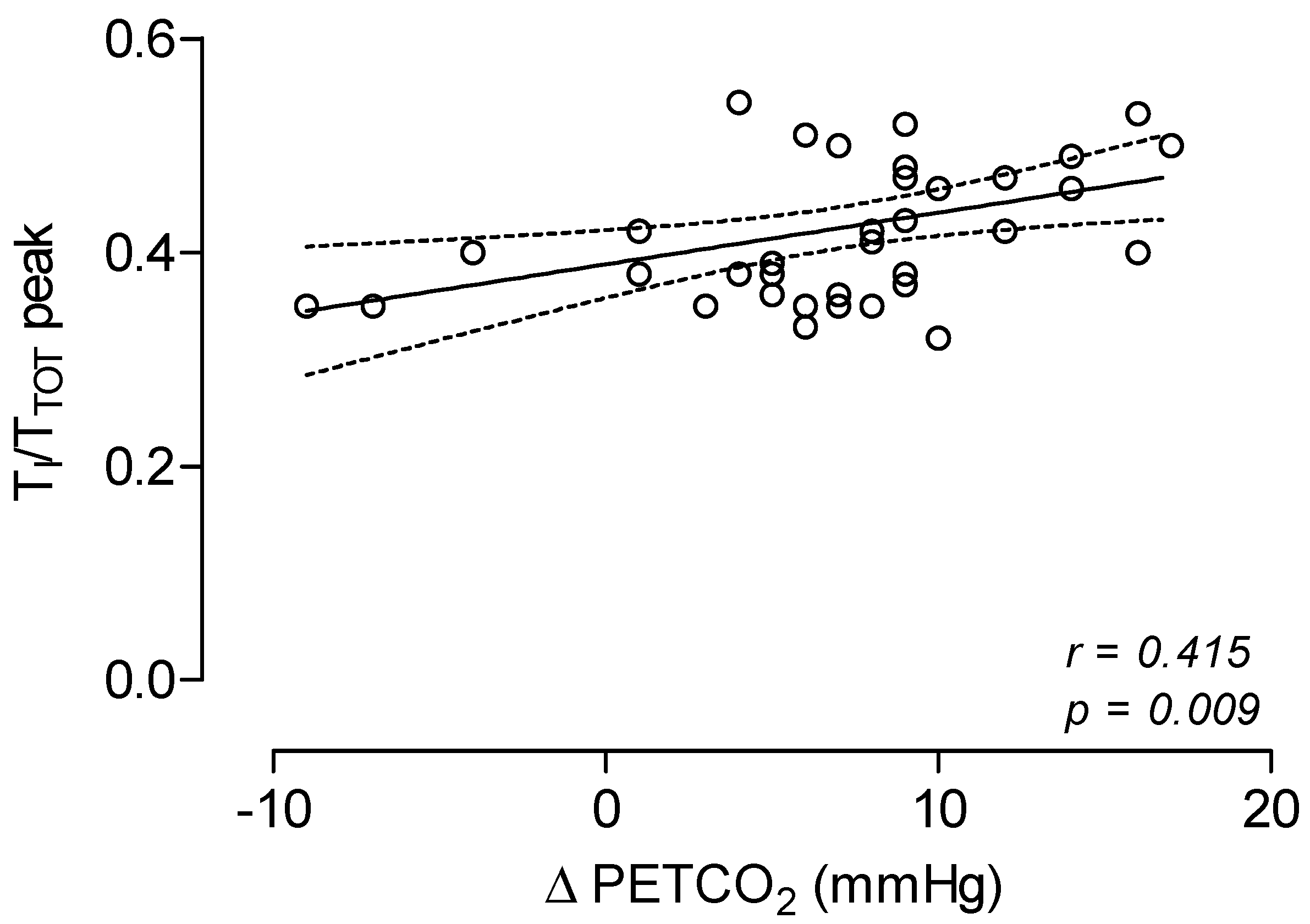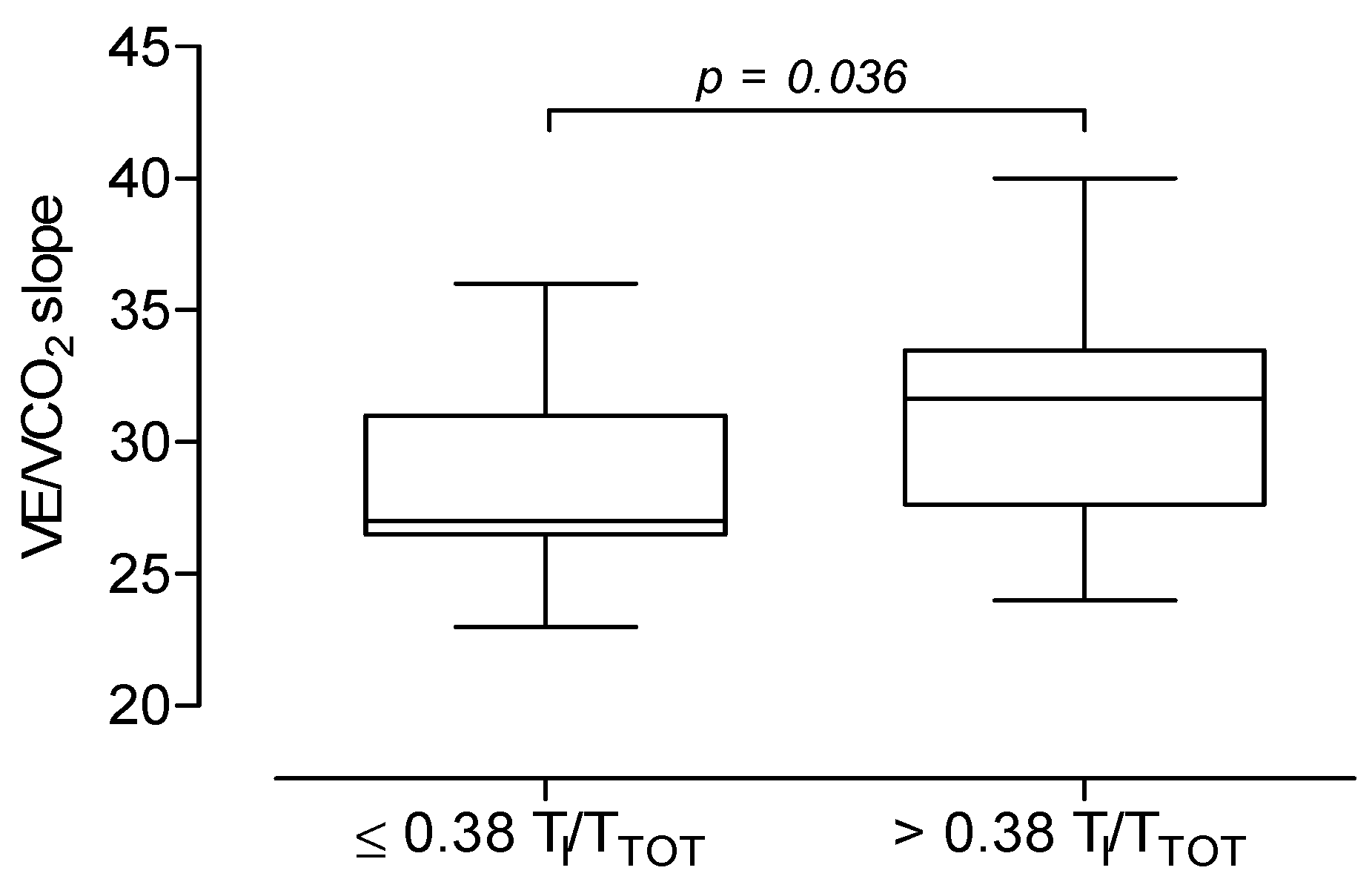An Impairment in Resting and Exertional Breathing Pattern May Occur in Long-COVID Patients with Normal Spirometry and Unexplained Dyspnoea
Abstract
1. Introduction
2. Methods
2.1. Patients
2.2. Pulmonary Function and Cardiopulmonary Exercise Test
2.3. Statistical Analysis
3. Results
4. Discussion
Author Contributions
Funding
Institutional Review Board Statement
Informed Consent Statement
Data Availability Statement
Conflicts of Interest
References
- COVID-19 Rapid Guideline: Managing the Long-Term Effects of COVID-19; NICE Guideline, No. 188; National Institute for Health and Care Excellence (NICE): London, UK, 18 December 2020; ISBN-13: 978-1-4731-3943-5.
- Carfì, A.; Bernabei, R.; Landi, F.; Gemelli against COVID-19 Post-Acute Care Study Group. Persistent symptoms in patients after acute COVID-19. JAMA 2020, 324, 603–605. [Google Scholar] [CrossRef] [PubMed]
- Skjørten, I.; Ankerstjerne, O.A.W.; Trebinjac, D.; Brønstad, E.; Rasch-Halvorsen, Ø.; Einvik, G.; Lerum, T.V.; Stavem, K.; Edvardsen, A.; Ingul, C.B. Cardiopulmonary exercise capacity and limitations 3 months after COVID-19 hospitalisation. Eur. Respir. J. 2021, 58, 2100996. [Google Scholar] [CrossRef] [PubMed]
- Rinaldo, R.R.; Mondoni, M.; Parazzini, E.M.; Pitari, F.; Brambilla, E.; Luraschi, S.; Balbi, M.; Papa, G.F.S.; Sotgiu, G.; Guazzi, M.; et al. Deconditioning as main mechanism of impaired exercise response in COVID-19 survivors. Eur. Respir. J. 2021, 58, 2100870. [Google Scholar] [CrossRef] [PubMed]
- Motiejunaite, J.; Balagny, P.; Arnoult, F.; Mangin, L.; Bancal, C.; Vidal-Petiot, E.; Flamant, M.; Jondeau, G.; Cohen-Solal, A.; d’Ortho, M.-P.; et al. Hyperventilation as one of the mechanisms of persistent dyspnoea in SARS-CoV-2 survivors. Eur. Respir. J. 2021, 58, 2101578. [Google Scholar] [CrossRef] [PubMed]
- Mancini, D.M.; Brunjes, D.L.; Lala, A.; Trivieri, M.G.; Contreras, J.P.; Natelson, B.H. Use of Cardiopulmonary Stress Testing for Patients with Unexplained Dyspnea Post-Coronavirus Disease. JACC Heart Fail. 2021, 9, 927–937. [Google Scholar] [CrossRef] [PubMed]
- Frésard, I.; Genecand, L.; Altarelli, M.; Gex, G.; Vremaroiu, P.; Vremaroiu-Coman, A.; Lawi, D.; Bridevaux, P.O. Dysfunctional breathing diagnosed by cardiopulmonary exercise testing in ‘long COVID’ patients with persistent dyspnoea. BMJ Open Respir. Res. 2022, 9, e001126. [Google Scholar] [CrossRef] [PubMed]
- von Gruenewaldt, A.; Nylander, E.; Hedman, K. Classification and occurrence of an abnormal breathing pattern during cardiopulmonary exercise testing in subjects with persistent symptoms following COVID-19 disease. Physiol. Rep. 2022, 10, e15197. [Google Scholar] [CrossRef] [PubMed]
- Barker, N.; Everard, M.L. Getting to grips with ‘dysfunctional breathing’. Paediatr. Respir. Rev. 2015, 16, 53–61. [Google Scholar] [CrossRef] [PubMed]
- Boulding, R.; Stacey, R.; Niven, R.; Fowler, S.J. Dysfunctional breathing: A review of the literature and proposal for classification. Eur. Respir. Rev. 2016, 25, 287–294. [Google Scholar] [CrossRef] [PubMed]
- Tobin, M.J. Breathing pattern analysis. Intensive Care Med. 1992, 18, 193–201. [Google Scholar] [CrossRef] [PubMed]
- Lind, F.; Hesser, C.M. Breathing pattern and lung volumes during exercise. Acta Physiol. Scand. 1984, 120, 123–129. [Google Scholar] [CrossRef] [PubMed]
- Graham, B.L.; Steenbruggen, I.; Miller, M.R.; Barjaktarevic, I.Z.; Cooper, B.G.; Hall, G.L.; Hallstrand, T.S.; Kaminsky, D.A.; McCarthy, K.; McCormack, M.C.; et al. Standardization of spirometry 2019 update an official American Thoracic Society and European Respiratory Society technical statement. Am. J. Respir. Crit. Care Med. 2019, 200, E70–E88. [Google Scholar] [CrossRef] [PubMed]
- Quanjer, P.H.; Tammeling, G.J.; Cotes, J.E.; Pedersen, O.F.; Peslin, R.; Yernault, J.C. Lung volumes and forced ventilatory flows. Report working party standardization of lung function tests, European community for steel and oral official statement of the European respiratory society. Eur. Respir. J. 1993, 6, 5–40. [Google Scholar] [CrossRef] [PubMed]
- Ross, R.M. ATS/ACCP Statement on cardiopulmonary exercise testing. Am. J. Respir. Crit. Care Med. 2003, 167, 211–277. [Google Scholar] [CrossRef] [PubMed]
- Wasserman, K.; Hansen, J.E.; Sue, D.Y.; Casaburi, R.; Whipp, B.J. (Eds.) Normal values. In Principles of Exercise Testing & Interpretation; Lippincott Williams & Wilkins: Philadelphia, PA, USA, 1994; pp. 143–162. [Google Scholar]
- Baba, R.; Nagashima, M.; Goto, M.; Nagano, Y.; Yokota, M.; Tauchi, N.; Nishibata, K. Oxygen uptake efficiency slope: A new index of cardiorespiratory functional reserve derived from the relation between oxygen uptake and minute ventilation during incremental exercise. J. Am. Coll. Cardiol. 1996, 28, 1567–1572. [Google Scholar] [CrossRef] [PubMed]
- Cole, C.R.; Blackstone, E.H.; Pashkow, F.J.; Snader, C.E.; Lauer, M.S. Heart-rate recovery immediately after exercise as a predictor of mortality. N. Engl. J. Med. 1999, 341, 1351–1357. [Google Scholar] [CrossRef] [PubMed]
- Singh, I.; Joseph, P.; Heerdt, P.M.; Cullinan, M.; Lutchmansingh, D.D.; Gulati, M.; Possick, J.D.; Systrom, D.M.; Waxman, A.B. Persistent Exertional Intolerance After COVID-19: Insights from Invasive Cardiopulmonary Exercise Testing. Chest 2022, 161, 54–63. [Google Scholar] [CrossRef]
- Bellemare, F.; Grassino, A. Evaluation of human diaphragm fatigue. J. Appl. Physiol. Respir. Environ. Exerc. Physiol. 1982, 53, 1196–1206. [Google Scholar] [CrossRef]
- Lederer, D.H.; Altose, M.D.; Kelsen, S.G.; Cherniack, N.S. Comparison of occlusion pressure and ventilatory responses. Thorax 1977, 32, 212–220. [Google Scholar] [CrossRef] [PubMed]
- Gayan-Ramirez, G.; Decramer, M. Effects of mechanical ventilation on diaphragm function and biology. Eur. Respir. J. 2002, 20, 1579–1586. [Google Scholar] [CrossRef] [PubMed]





| Variables | Healthy Controls (No. 40) | Long COVID Patients (No. 42) | p |
|---|---|---|---|
| Age (years) | 47 ± 11 | 49 ± 12 | 0.494 |
| Sex (F/M) | 22/18 | 23/19 | 0.983 |
| BMI (Kg/m2) | 25 ± 4 | 26 ± 3 | 0.121 |
| FVC (% pred) | 108 ± 15 | 101 ± 17 | 0.066 |
| FEV1 (% pred) | 106 ± 12 | 99 ± 15 | 0.025 |
| FEV1/FVC (%) | 82 ± 6 | 81 ± 6 | 0.255 |
| VO2 peak (mL/kg/min) | 31 ± 10 | 23 ± 8 | 0.001 |
| VO2 peak (% pred) | 105 ± 27 | 84 ± 21 | 0.001 |
| Workload (Watts) | 181 ± 65 | 123 ± 43 | 0.001 |
| Workload (% pred) | 117 ± 36 | 82 ± 22 | 0.001 |
| AT (mL/kg/min) | 21 ± 10 | 16 ± 8 | 0.030 |
| O2 Pulse rest (mL/bpm) | 4.9 ± 2.4 | 4.1 ± 1.3 | 0.069 |
| O2 Pulse peak (mL/bpm) | 14.6 ± 4.5 | 11.7 ± 3.6 | 0.002 |
| OUES (mL/min) | 2288 ± 687 | 1688 ± 686 | 0.001 |
| HR rest (bpm) | 75 ± 14 | 85 ± 15 | 0.002 |
| HR peak (bpm) | 152 ± 19 | 147 ± 15 | 0.217 |
| HR peak (% pred) | 88 ± 9 | 86 ± 8 | 0.377 |
| HR recovery (bpm) | 25 ± 9 | 20 ± 10 | 0.009 |
| BR (%) | 50 ± 11 | 51 ± 14 | 0.768 |
| VE peak (L/min) | 72 ± 26 | 59 ± 21 | 0.023 |
| Vt rest (L) | 0.74 ± 0.3 | 0.74 ± 0.3 | 0.994 |
| Vt peak (L) | 2.37 ± 0.8 | 1.97 ± 0.5 | 0.007 |
| RR rest (bpm) | 14 ±5 | 14 ± 6 | 0.770 |
| RR peak (bpm) | 31 ± 7 | 31 ± 9 | 0.847 |
| PETCO2 rest (mmHg) | 33 ± 6 | 34 ± 4 | 0.319 |
| PETCO2 peak (mmHg) | 41 ± 5 | 41 ± 5 | 0.921 |
| Δ PETCO2 (mmHg) | 8 ± 6 | 7 ± 5 | 0.468 |
| VE/VCO2 Slope (L) | 26 ± 4 | 30 ± 4 | 0.001 |
| TI/TTot rest | 0.29 ± 0.09 | 0.36 ± 0.09 | 0.001 |
| TI/TTot peak | 0.39 ± 0.05 | 0.42 ± 0.06 | 0.034 |
| VT/TI rest (mL/s) | 685 ± 397 | 605 ± 262 | 0.286 |
| VT/TI peak (mL/s) | 3155 ± 1101 | 2560 ± 850 | 0.008 |
| VAS dyspnoea (mm/watts) | 0.48 ± 0.19 | 0.64 ± 0.22 | 0.022 |
Publisher’s Note: MDPI stays neutral with regard to jurisdictional claims in published maps and institutional affiliations. |
© 2022 by the authors. Licensee MDPI, Basel, Switzerland. This article is an open access article distributed under the terms and conditions of the Creative Commons Attribution (CC BY) license (https://creativecommons.org/licenses/by/4.0/).
Share and Cite
Frizzelli, A.; Di Spigno, F.; Moderato, L.; Halasz, G.; Aiello, M.; Tzani, P.; Manari, G.; Calzetta, L.; Pisi, R.; Pelà, G.; et al. An Impairment in Resting and Exertional Breathing Pattern May Occur in Long-COVID Patients with Normal Spirometry and Unexplained Dyspnoea. J. Clin. Med. 2022, 11, 7388. https://doi.org/10.3390/jcm11247388
Frizzelli A, Di Spigno F, Moderato L, Halasz G, Aiello M, Tzani P, Manari G, Calzetta L, Pisi R, Pelà G, et al. An Impairment in Resting and Exertional Breathing Pattern May Occur in Long-COVID Patients with Normal Spirometry and Unexplained Dyspnoea. Journal of Clinical Medicine. 2022; 11(24):7388. https://doi.org/10.3390/jcm11247388
Chicago/Turabian StyleFrizzelli, Annalisa, Francesco Di Spigno, Luca Moderato, Geza Halasz, Marina Aiello, Panagiota Tzani, Gaia Manari, Luigino Calzetta, Roberta Pisi, Giovanna Pelà, and et al. 2022. "An Impairment in Resting and Exertional Breathing Pattern May Occur in Long-COVID Patients with Normal Spirometry and Unexplained Dyspnoea" Journal of Clinical Medicine 11, no. 24: 7388. https://doi.org/10.3390/jcm11247388
APA StyleFrizzelli, A., Di Spigno, F., Moderato, L., Halasz, G., Aiello, M., Tzani, P., Manari, G., Calzetta, L., Pisi, R., Pelà, G., Piepoli, M., & Chetta, A. (2022). An Impairment in Resting and Exertional Breathing Pattern May Occur in Long-COVID Patients with Normal Spirometry and Unexplained Dyspnoea. Journal of Clinical Medicine, 11(24), 7388. https://doi.org/10.3390/jcm11247388







